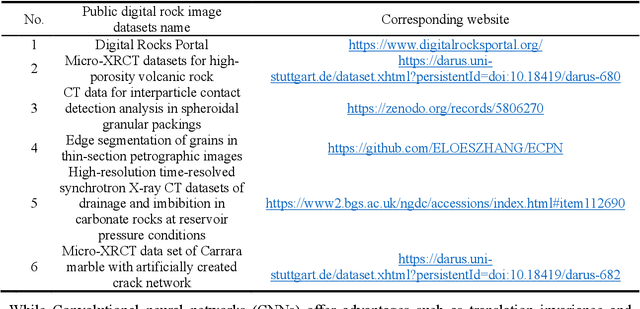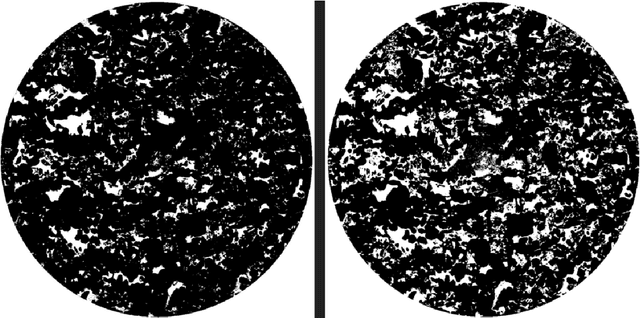Hyung Kwak
Memory-Efficient Super-Resolution of 3D Micro-CT Images Using Octree-Based GANs: Enhancing Resolution and Segmentation Accuracy
May 24, 2025Abstract:We present a memory-efficient algorithm for significantly enhancing the quality of segmented 3D micro-Computed Tomography (micro-CT) images of rocks using a generative model. The proposed model achieves a 16x increase in resolution and corrects inaccuracies in segmentation caused by the overlapping X-ray attenuation in micro-CT measurements across different minerals. The generative model employed is a 3D Octree-based convolutional Wasserstein generative adversarial network with gradient penalty. To address the challenge of high memory consumption inherent in standard 3D convolutional layers, we implemented an Octree structure within the 3D progressive growing generator model. This enabled the use of memory-efficient 3D Octree-based convolutional layers. The approach is pivotal in overcoming the long-standing memory bottleneck in volumetric deep learning, making it possible to reach 16x super-resolution in 3D, a scale that is challenging to attain due to cubic memory scaling. For training, we utilized segmented 3D low-resolution micro-CT images along with unpaired segmented complementary 2D high-resolution laser scanning microscope images. Post-training, resolution improved from 7 to 0.44 micro-m/voxel with accurate segmentation of constituent minerals. Validated on Berea sandstone, this framework demonstrates substantial improvements in pore characterization and mineral differentiation, offering a robust solution to one of the primary computational limitations in modern geoscientific imaging.
Super-Resolution of 3D Micro-CT Images Using Generative Adversarial Networks: Enhancing Resolution and Segmentation Accuracy
Jan 12, 2025Abstract:We develop a procedure for substantially improving the quality of segmented 3D micro-Computed Tomography (micro-CT) images of rocks with a Machine Learning (ML) Generative Model. The proposed model enhances the resolution eightfold (8x) and addresses segmentation inaccuracies due to the overlapping X-ray attenuation in micro-CT measurement for different rock minerals and phases. The proposed generative model is a 3D Deep Convolutional Wasserstein Generative Adversarial Network with Gradient Penalty (3D DC WGAN-GP). The algorithm is trained on segmented 3D low-resolution micro-CT images and segmented unpaired complementary 2D high-resolution Laser Scanning Microscope (LSM) images. The algorithm was demonstrated on multiple samples of Berea sandstones. We achieved high-quality super-resolved 3D images with a resolution of 0.4375 micro-m/voxel and accurate segmentation for constituting minerals and pore space. The described procedure can significantly expand the modern capabilities of digital rock physics.
Zero-Shot Digital Rock Image Segmentation with a Fine-Tuned Segment Anything Model
Nov 17, 2023Abstract:Accurate image segmentation is crucial in reservoir modelling and material characterization, enhancing oil and gas extraction efficiency through detailed reservoir models. This precision offers insights into rock properties, advancing digital rock physics understanding. However, creating pixel-level annotations for complex CT and SEM rock images is challenging due to their size and low contrast, lengthening analysis time. This has spurred interest in advanced semi-supervised and unsupervised segmentation techniques in digital rock image analysis, promising more efficient, accurate, and less labour-intensive methods. Meta AI's Segment Anything Model (SAM) revolutionized image segmentation in 2023, offering interactive and automated segmentation with zero-shot capabilities, essential for digital rock physics with limited training data and complex image features. Despite its advanced features, SAM struggles with rock CT/SEM images due to their absence in its training set and the low-contrast nature of grayscale images. Our research fine-tunes SAM for rock CT/SEM image segmentation, optimizing parameters and handling large-scale images to improve accuracy. Experiments on rock CT and SEM images show that fine-tuning significantly enhances SAM's performance, enabling high-quality mask generation in digital rock image analysis. Our results demonstrate the feasibility and effectiveness of the fine-tuned SAM model (RockSAM) for rock images, offering segmentation without extensive training or complex labelling.
Enhancing Rock Image Segmentation in Digital Rock Physics: A Fusion of Generative AI and State-of-the-Art Neural Networks
Nov 10, 2023



Abstract:In digital rock physics, analysing microstructures from CT and SEM scans is crucial for estimating properties like porosity and pore connectivity. Traditional segmentation methods like thresholding and CNNs often fall short in accurately detailing rock microstructures and are prone to noise. U-Net improved segmentation accuracy but required many expert-annotated samples, a laborious and error-prone process due to complex pore shapes. Our study employed an advanced generative AI model, the diffusion model, to overcome these limitations. This model generated a vast dataset of CT/SEM and binary segmentation pairs from a small initial dataset. We assessed the efficacy of three neural networks: U-Net, Attention-U-net, and TransUNet, for segmenting these enhanced images. The diffusion model proved to be an effective data augmentation technique, improving the generalization and robustness of deep learning models. TransU-Net, incorporating Transformer structures, demonstrated superior segmentation accuracy and IoU metrics, outperforming both U-Net and Attention-U-net. Our research advances rock image segmentation by combining the diffusion model with cutting-edge neural networks, reducing dependency on extensive expert data and boosting segmentation accuracy and robustness. TransU-Net sets a new standard in digital rock physics, paving the way for future geoscience and engineering breakthroughs.
 Add to Chrome
Add to Chrome Add to Firefox
Add to Firefox Add to Edge
Add to Edge